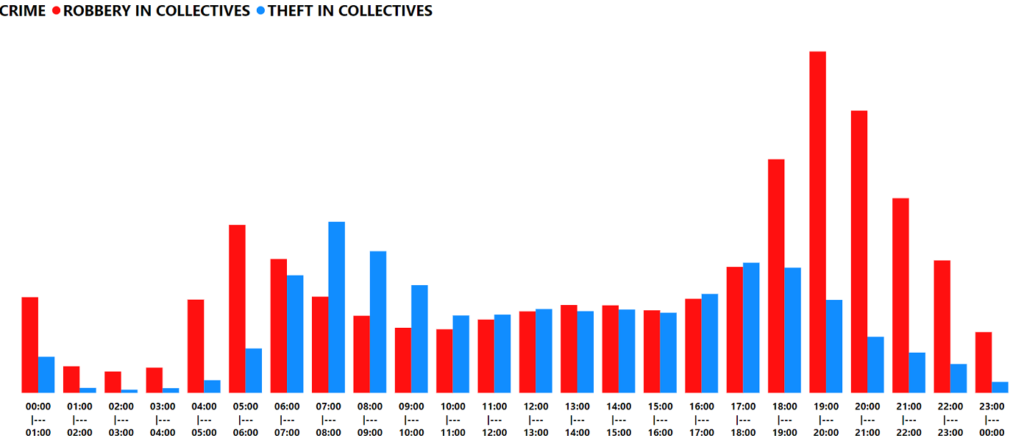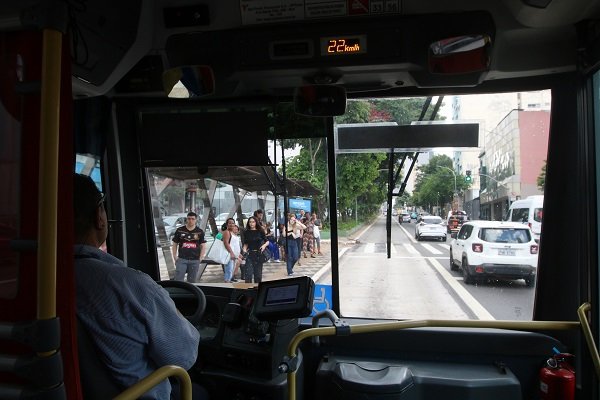SUMMARY
This article delves into the challenges confronting public transportation in Rio de Janeiro, particularly focusing on incidents like bus hijackings and instances of violence, shedding light on the severity of robberies and thefts on buses. Statistical data illustrates the gravity of the situation, showcasing fluctuations in crime rates over the years and discussing their ramifications on urban mobility and citizens’ quality of life. Moreover, the article explores the necessary measures to tackle these challenges and ensure the safety of both passengers and workers in the public transport sector.
The analysis is exclusive, and it draws from data provided by the Public Security Institute of Rio de Janeiro (ISP), obtained through a specific request – nº 5862381012698679387 – made through the Access to Information Law (LA), covering theft and robbery in public transportation from January 2018 to September 2023. Adjustments were made to streamline data processing, retaining essential columns such as control, conduct, crime, date, and location, and focusing on crimes of interest to ensure the accuracy and relevance of the analysis to the stated objectives.
Bus Hijacking at Rio Bus Station
On 12 March, 16 passengers were taken hostage for three hours on a bus at Rio Bus Station, also known as Novo Rio. The criminal, allegedly linked to drug trafficking in the community of Muzema, West Zone of Rio, fired shots, leaving two people injured, one severely. BOPE, an elite Military Police troop, was called in to negotiate the surrender, resulting in the release of all victims kidnapped.
The kidnapper, identified as Paulo Sérgio, told the police that he was fleeing for fear of reprisals after a confrontation in the community of Rocinha, in the South Zone of Rio. He claimed that, when he bought the ticket, he thought he had aroused suspicion because he was carrying a considerable amount of money.
Shortly after leaving the bus station towards Minas, the bus began to have air conditioning problems. With that, the driver decided to return to the bus station. Some passengers disembarked due to the heat, and it was during this moment that the hijacking began.
Paulo Sérgio told the police that, upon noticing movement around the bus at the bus station, he feared being captured by drug traffickers. Upon seeing a passenger return to the vehicle, he assumed it was a police officer and reacted by shooting, injuring a Petrobras employee named Bruno Lima da Costa, aged 34, and beginning the kidnapping that would last three hours.
Public Transportation in Rio
Public transport plays a crucial role in the daily lives of residents of the Metropolitan Region of Rio de Janeiro (RMRJ), being essential to guarantee urban mobility and provide access to jobs, services, and leisure. According to data from the Coppe/UFRJ Transport Engineering Program (PET), in 2023, around 115 million daily bus trips were made in the region, demonstrating the high dependence on this mode of transport.
In addition to bus transport, the subway, ferries, and trains also play significant roles in RMRJ’s public transport network. In 2023, approximately 9.9 million daily trips were recorded on the subway, 747,000 on ferries, and 4.9 million on trains, according to data from the same study.
However, despite the importance of public transport, the quality of services offered faces several challenges in the region. According to the WRI Brasil Institute, the main problems faced by bus users in RMRJ include high fares, overcrowding, long travel times, and lack of security. The constant reports of robberies and thefts from buses and passengers have a direct impact on the quality of service provided to the population. The perception of insecurity can lead passengers to migrate to other modes of transport or even opt for individual alternatives, such as using ride-hailing apps or private vehicles.
Capital and Metropolitan Region
During the period between January 2018 and September 2023, a total of 100,152 incidents of robberies and thefts on public transport were recorded in the state of Rio de Janeiro. Our focus is directed to the Metropolitan Region of Rio de Janeiro (RMRJ), which encompasses not only the capital, Rio de Janeiro but also a significant set of adjacent cities, such as Duque de Caxias, São João de Meriti, Nova Iguaçu, and São Gonçalo. It is worth mentioning that this area stands out for housing most of the state’s population and representing a highly relevant economic hub.
In the period analyzed, from 2018 to 2023, RMRJ recorded a total of 97,464 cases of robberies and thefts on public transport, which is equivalent to more than 97% of the total recorded throughout the state. This figure translates into an annual average of 16,244 incidents, corresponding to 1,413 cases per month and approximately 46 daily occurrences.
By analyzing the data provided on robberies and thefts in collectives in the Metropolitan Region of Rio de Janeiro over the last six years, it is possible to identify significant trends and patterns.
In 2018, there was a high incidence of crimes against passengers and public transport operators, with 15,480 cases of robbery and 7,899 cases of theft recorded. However, over the following years, a downward trend in these rates became evident.
In 2019, the numbers continued to decline, with 14,903 cases of robbery and 7,330 cases of theft. In 2020, there was a sharp drop in theft cases, with just 9,192 incidents recorded, and an even more significant reduction in theft cases, with just 3,805 incidents. This decrease can be partially attributed to the effects of the COVID-19 pandemic, which resulted in mobility restrictions and a reduction in the movement of people.

However, as of 2021, the numbers began to rise again, with 9,598 robbery cases and 4,997 theft cases recorded that year. This upward trend continued in 2022, with 6,744 cases of robbery and 7,722 cases of theft.
Although we do not have data for the entire year 2023, only until September, it is possible to notice a downward trend compared to 2022. Until September 2023, 4,106 incidents of robberies and 5,688 incidents of theft were recorded. This means an average of 15 cases of robbery and 21 cases of theft per day. In comparison, until the same period in 2022, a greater number of cases had been recorded, with 5,196 robberies and 5,808 thefts. Which means an average of 19 cases of robbery and 22 cases of theft per day.
We can distinguish between robberies and theft, and thus it is essential to highlight that the distinction between those crimes lies in the presence of violence in the first, and the absence of this factor in the second.
By exclusively analyzing cases of robbery in the last year the full data is available (2022), the city of Rio leads the records, with 62.23% of cases (6,744 cases) – an average of 18 cases per day -, followed by Duque de Caxias, which accounts for 12.92% (871 cases) and São João de Meriti with 7.73% (521 cases).
These crimes occur more frequently on weekdays, especially between 18:00 and 21:00. This period coincides with public transport peak hours when most workers return home. The city of Rio also records another peak period in the morning, between 4:00 and 7:00, coinciding with the busiest time on public transport due to workers leaving their homes.

When analyzing data relating to thefts on public transport in the Metropolitan Region, during 2022, 7,722 cases of theft on public transport were recorded, with 90.25% of these incidents occurring in the city of Rio de Janeiro, totaling 6,969 cases. Next, we have Niterói with 1.71% (132 cases) and Duque de Caxias with 1.58% (122 cases) which do not present relevant figures. Thefts occur at two times of highest incidence. The first and most significant occurs between 6:00 and 9:00, a period that coincides with the first peak hour for public transport when most workers are commuting to work. The second time slot, between 17:00 and 19:00, also records occurrences, although in smaller numbers compared to the first. This period coincides with the second peak hour for public transport when workers are returning home after work.
Rates per 100,000 inhabitants
For a more proportional comparison between the cities in the Metropolitan Region of Rio, it was calculated their rates of robberies and thefts per 100,000 inhabitants. This statistical approach adjusts crime data according to the population of each location, allowing for a more accurate and meaningful comparison between areas, regardless of population size.
When observing the rates of robberies and thefts per 100,000 inhabitants in the Metropolitan Region of Rio de Janeiro between 2018 and 2022, it was noticed that Rio de Janeiro consistently stands out with the highest rates compared to other cities in the region throughout the analyzed period. In 2020, during the COVID-19 pandemic, there was a drastic fall in rates, due to restrictions on movement. At this moment, due to resistance from some mayors and populations of surrounding cities to adopt and follow social isolation measures, the capital was surpassed by São João de Meriti in 2020 and 2021.
Other cities that frequently appear among those with the highest rates of robberies and thefts include Duque de Caxias, Mesquita, Nova Iguaçu, and São Gonçalo.
Traffickers, Militiamen, and Alternative Transport
In Rio de Janeiro, the alternative transport system, which consists of a network of vans, is often “regulated” by factions linked to drug trafficking and militiamen, depending on the region in which the vehicle circulates. In this context, there is no distinction between legal and irregular vans, all are required to pay fees imposed by local criminals.
In 2021, although the city of Rio de Janeiro registered around 2,000 legal vans, a count by RioÔnibus, the sector’s union, showed that another 8,000 vehicles operate without supervision. These numbers reveal a significant discrepancy between officially recognized vans and those operating clandestinely.
Alternative transport is especially prevalent in more deprived areas of the metropolitan region, where traditional public transport provision is scarce.
From 2018 to September 2022, 1,438 robberies and 733 thefts in alternative transports were recorded in the Metropolitan Region of Rio de Janeiro. However, it is important to highlight that these numbers probably underestimate reality, due to underreporting of crimes. The control exercised by traffickers and militiamen can dissuade victims from reporting incidents or lead them not to report the fact to the authorities.
Train and Subway
Because trains and metro systems run in reasonably controlled spaces, platforms, and railways protected by walls and fences, they tend to be more secure when compared to buses and other types of public transport on public road. However, in Rio, both systems pass through dangerous zones, which are the stage of gang disputes. On top of that, police officers are not capable of efficiently patrolling the entire length of these systems, which facilitates the actions of common criminals and organized crime.
While the metro network is less exposed, for being shorter, with a great part of its extension underground, and limited to the territory of the capital; the train system is larger, runs to more diverse and poorer areas, and it is 100% on the surface.
These differences, mainly in terms of circulation areas, directly influence the number of criminal incidents recorded in each mode. On trains, which operate in suburban and metropolitan regions, 1,195 cases of robbery and theft were recorded within trains and stations, from 2018 to September 2023. This is equivalent to an average of 199 cases per year or 17 cases per month.
Meanwhile, the subway, which runs mainly within the city of Rio de Janeiro, connecting the north, south, and center zones, recorded 520 cases of theft and robbery in the same period. This annual average of 87 cases and 8 monthly cases reflects the difference in security conditions between these two rail transportation modes.

Beyond Robberies
The public transport system in Rio de Janeiro faces a series of complex challenges, going beyond incidents of robbery and theft. In both rail and bus services, problems such as cable thefts, shootings, and attacks on drivers have adversely affected the operation of these services.
In rail transport, the main problems include cable theft and shootings, which significantly affect the functioning of the service. Between February 2022 and March 2023, Supervia – the train operator – recorded 1,701 incidents of cable theft in its system — that’s more than four thefts per day. The loss was R$12 million. The Deodoro Branch appears at the top of the ranking of theft occurrences, and the most problematic stretches are between the Riachuelo and Engenho Novo stations and between Engenho de Dentro and Quintino. Beyond the financial loss to the operator, there are the consequences to the public and service is often stopped due to damages caused by the subtraction of cables.
Additionally, shootings also represent a significant problem. In 2020, the SuperVia concessionaire recorded 36 cases of shootings near the railway line, which affected the circulation of trains for 40 hours and 24 minutes. The most affected branch was Saracuruna, in Duque de Caxias, in Baixada Fluminense, with 24 occurrences of interruptions.
As for buses, violence in Rio de Janeiro has led around 200 drivers to leave the profession in 2023, according to the Bus Workers Union. Among the reasons for this decision are cases of kidnappings, assaults, robberies, and other crimes, such as threats and fires. A recent example was the kidnapping of two bus drivers in the Vila Aliança community, in Bangu, West Zone, who were forced by criminals to park their buses to block the road during a police operation.
In another incident, a travel bus driver was kidnapped near the Rio Bus Station and forced to drive to a community in Penha, North Zone, while the passengers were robbed. According to Rio Ônibus, the Bus Companies Union of the City of Rio de Janeiro, in the last 12 months, 140 buses were used as barricades in access to communities and 28 buses were the target of arson.

Ensuring Security in Rio’s Public Transportation
When analyzing data on crimes on public transport in Rio de Janeiro, an unusual trend stands out: the prevalence of robberies over thefts. In general, in criminal studies, it is more common to find a higher incidence of theft than of robberies, due to the lower risk perceived by criminals. However, the reversal of this trend suggests a possible influence on victims’ willingness to report crimes. In contexts such as public transport, where victims often feel vulnerable and exposed, robberies are likely to be reported more frequently than thefts. This may be attributed to the violent and intimidating nature of robberies, which tend to generate a more immediate response from authorities and the media, encouraging victims to report incidents more frequently.

For those who need to travel around the city by public transport, some measures can help reduce the risk of being robbed. Avoiding peak times, both in the morning (between 6:00 and 9:00) and at night (between 17:00 and 20:00), can reduce exposure to risk situations. Furthermore, it is advisable to avoid traveling in empty buses or carriages, as this may attract the attention of robbers.
Keeping cell phones or any valuable object out of sight and in safe places, such as internal pockets or closed bags, can make people less attractive targets for criminals while traveling. Also avoiding waiting for public transport in isolated and poorly lit places is recommended, as these areas are often targets for robberies.
Even though the database of crimes used to prepare this article does not precisely identify crimes for each kind of public transport, general circumstances and history show that buses are much more exposed to risk in Rio de Janeiro. They carry on average, according to Rio Ônibus, 1,052 million passengers every day and enter zones of all kinds, including those disputed by organized crime. Bus stations and vehicles are more easily targeted by criminals and cannot count on the protection of walls and dedicated security teams, like the metro and the train.
While the train system appears to be a safer option. It is yet quite a risky one. This is to be attributed to the fact that the service completely runs on the surface and serves a population in the violent suburbs of this capital. In addition, the walk between the station and the destination may be subject to assault.
Lastly, the metro seems to stand as the safest option, particularly the stations and the part of its tracks that are underground and in less dangerous neighborhoods, lines 1 and 4. However its network is underdeveloped.
From 2018 to 2023, the number of crimes reported in public transport reduced, especially during the pandemic. Still, despite a small increase, in 2022, the numbers did not return to the pre-pandemic level. A great part of this improvement could be attributed to the reduction in the number of passengers, which also did not return to those seen in times before the COVID crisis, as many keep working from home.
Improvements in the security conditions of public transport depend on a large and general effort at public security and would be helped by the development of the metro network. Since Rio is currently struggling to contain violence in general, with an ongoing federal intervention helping local police forces patrol roads, ports, and airports, further improvements in the conditions of local transport will hardly happen shortly and could even be reversed if socioeconomic shifts lead to an increase in the number of passengers, or even gang wars near the train, subway, and bus lines.




